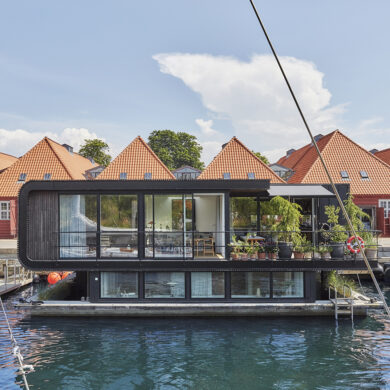Lundgaard & Tranberg: The Architect’s Reflections
Lene Tranberg carefully considers the historical context of architecture and human life and strives for a caring and responsible use of nature’s resources. It is essential, she feels, to consider the historical background in order to arrive at a fully rounded narrative. In her own home, which dates from 1896, she has preserved the original wooden floors, and some of the wooden window frames are of a similar age.
Details
Case
Type
Model
Material


‘Architecture is layer upon layer, which we keep adding to. To me, architecture is like the annual rings of a tree, where there is a gradual refinement from one layer to the next, and where everything points back to and is incorporated into the origin,’
‘Architecture is layer upon layer, which we keep adding to. To me, architecture is like the annual rings of a tree, where there is a gradual refinement from one layer to the next, and where everything points back to and is incorporated into the origin,’ says Lene Tranberg, an architect, partner and co-founder of Lundgaard & Tranberg Architects.
The studio has created many award-winning projects with humanism, simplification and craftsmanship as core virtues. In Lene Tranberg’s view, good architecture attracts people and contributes to community-building.
‘To us, architecture is always about atmosphere. It is about listening to a place, finding the tone and the energy that flows through everything. That is where it begins.’


‘Our collaboration with Søren Hvalsøe Garde and our joint projects over the years have unfolded in an almost symbiotic process,’
Lene Tranberg co-designed her own cabinetmaker’s kitchen together with Boje Lundgaard back in 1992, when they moved the kitchen into the living room and opened the room up to the garden to let in the light. Their vision was to create an informal, open and inspiring atmosphere, a harmonious space for cooking, family time and dinner parties.
‘We dreamt of a new kitchen that would be differentiated from its functionality and help balance the room; that would let materials and proportions express themselves and provide added qualities to create a space that is more than a kitchen. The core concept is the suspended element, which adds depth to the room and a light, airy and inviting atmosphere that is underscored by the white shelves. With its simple expression, the module on the back wall could also be a long sideboard, a chest of drawers, a worktop,’ says Lene Tranberg. ‘Basically, you would be able to take it with you, like a piece of furniture.’
The architect-designed kitchen was realized by Søren Hvalsøe Garde – and today, the Lundgaard & Tranberg model is an absolute classic in the Garde Hvalsøe collection. Rooted in the Nordic architectural tradition and created in a congenial collaboration between the architect and the cabinetmaker, both driven by a desire to create enduring solutions and dedicated to nurturing quality craftsmanship.
‘Our collaboration with Søren Hvalsøe Garde and our joint projects over the years have unfolded in an almost symbiotic process,’ says Lene Tranberg.


‘We aimed for a hand-crafted quality combined with a frank and robust expression in order to create a working space where we could enjoy the quality of the solid wood, breathe with the living material and cook with abandon, confident in the knowledge that the kitchen could handle a few knocks,’
As an architect, Lene Tranberg loves it when constructions are allowed to shape and define architecture. Hence, the kitchen has a frank character, the finger-jointed drawers placed with little gaps in between to offer a peek of their content. Sense the construction. She considers it essential to imbue the frame with that expressive quality, as it underscores the great care that went into creating the solution and lends it a robust character that welcomes an active and vibrant everyday life.
‘We aimed for a hand-crafted quality combined with a frank and robust expression in order to create a working space where we could enjoy the quality of the solid wood, breathe with the living material and cook with abandon, confident in the knowledge that the kitchen could handle a few knocks. Even now, decades later, it wouldn’t make sense for me to sand down the worktop. The quality is explicit, and the worktop is beautiful the way it is – with its imprint of lived life,’ says Lene Tranberg, who appreciates wood for its warm expression and for its ability to age beautifully without losing its vitality.
The hand-crafted kitchen in the house from 1896 was conceived, drafted and designed to stand up to the impact of everyday life and continuously tell new stories of shared moments. Throughout her career, Lene Tranberg has made a virtue of simplicity and of letting materials and constructions speak for themselves in architecture that makes room for what really matters: the feelings, relations and resonance that emerge in a space when objects and people interact in a friendly and curious encounter. Living stories.








